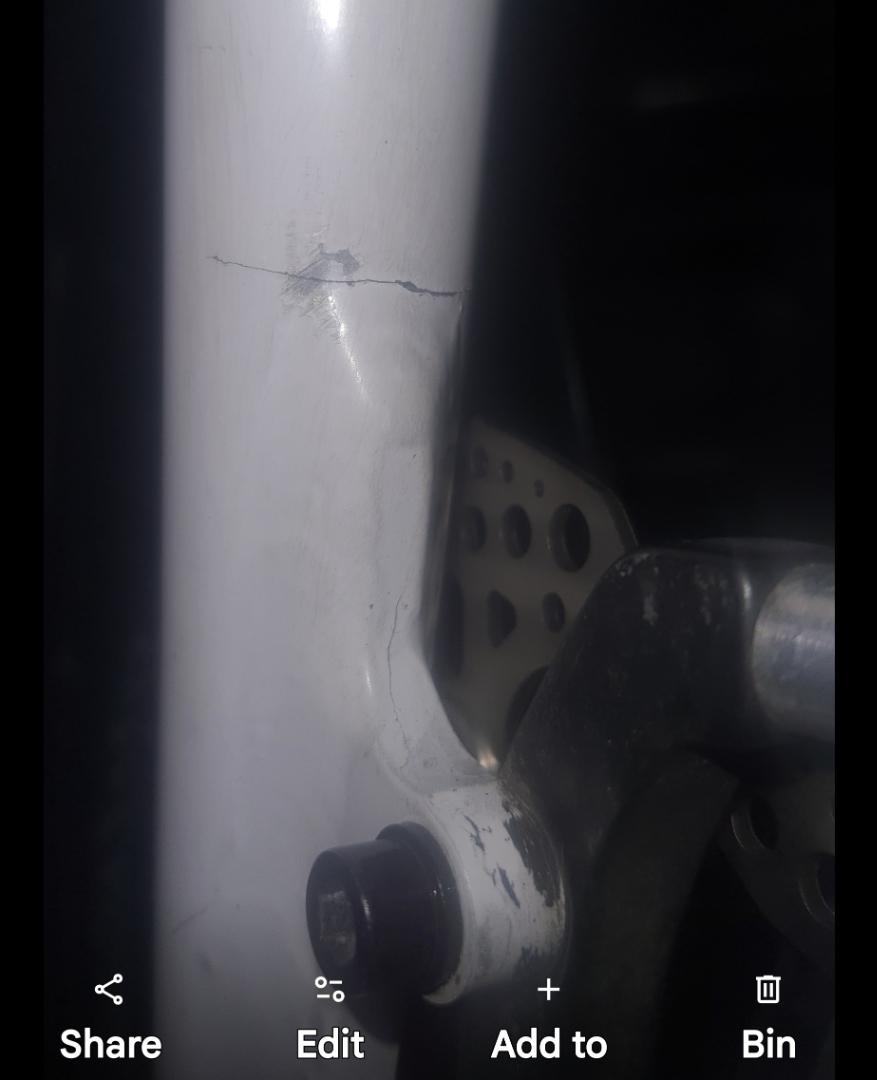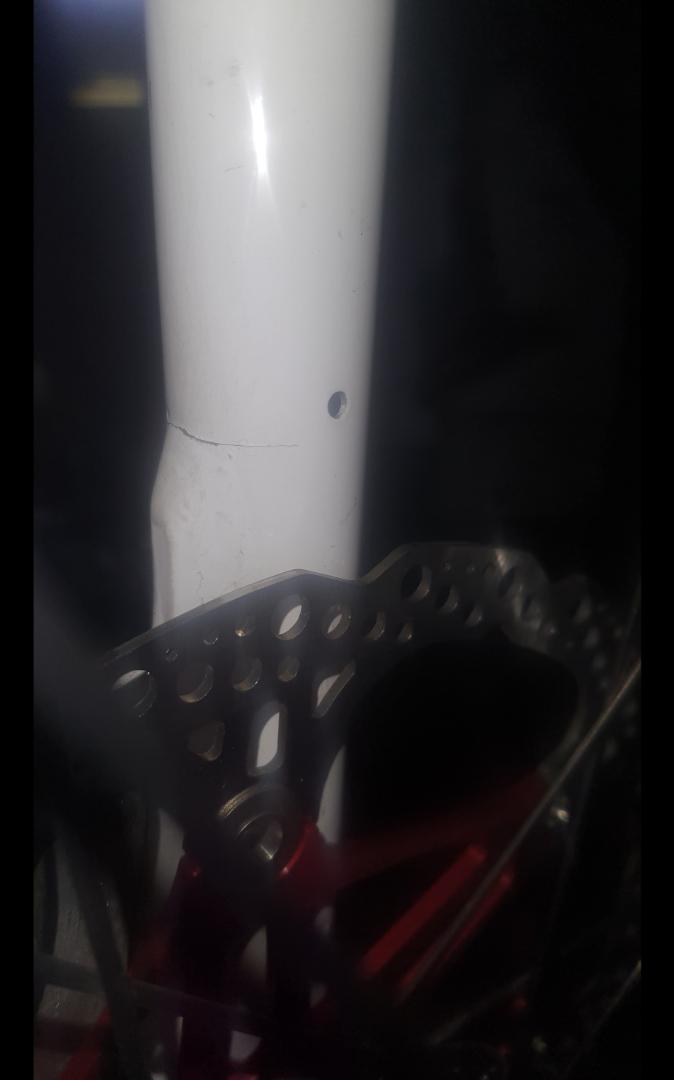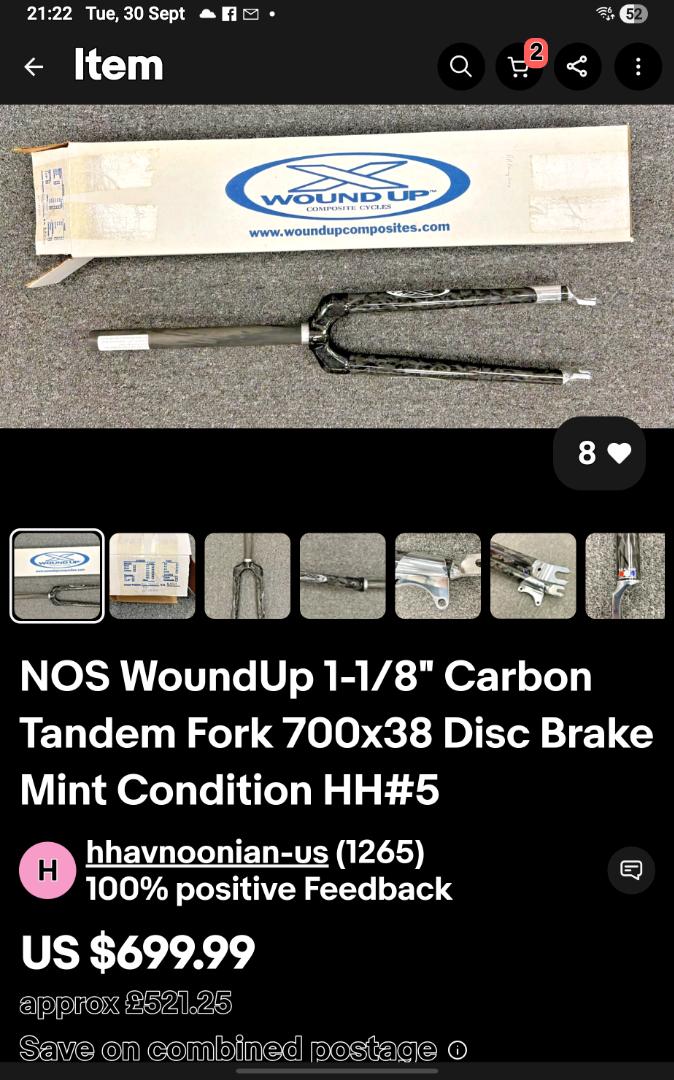Account
Discussions
Cannondale 'Fatty' fork failure
Hi everyone,
I was changing my disc pads and rotor this evening and noticed a stress fracture to my Cannondale fatty fork. There appears to be a crack spreading bilaterally from the upper edge of the IS disc mount involving about 180 degrees of the tube. I'm visually impaired but fortunately this was quite evident to touch which is how I noticed it. The front brake had developed a screach and judder, I was going to change the pads and rotor but I am guessing this is more likely the cause of the problem.
It's definitely terminal, I've included pictures and explanation mainly for people's interest.
Basic question is - I want to replace the fork , but what with?
I can easily buy a replacement tandem fork from someone like JD, quite inexpensive but weighs two kilograms. I would prefer something closer to the original. I could consider a Landescape fork - not too worried about the £500 if it is the right way to go, I'm just not really aware of other options in the UK. I would appreciate people's thoughts and advice. Thanks in advance, Steve

you need a fork built for a tandem and a tandem with a disk. So unfortunately, it will be heavy, stopping a Tandem with a disk Brake puts a lot of stress on the lower part of fork around the area you have the crack.
At least one tandem specialist refuses to fit disk brakes on the front of a tandem (Thorn).
The force generated by the weight of two people,"the bending moment" I believe it is called is considerable and will do exactly what you have seen to a fork that isn't sufficiently robust. Some may think there is no fork that isn't sufficiently robust (Thorn).Obviously JD Tandems fit disc brakes to their Orbits. i am told that they have never had a problem so far. When I asked specifically if the fork had been designed for a tandem with disk brakes I didn't get a convincing answer, so I decided to go with a rear disk brake and a V brake at the front initially. Would like to go to disk but waiting to see how reliable the forks are over the long term.
Thorn must have changed their opinion
https://www.sjscycles.co.uk/thorn-tandem-replacement-forks/
it sounds like the landescape fork is the way you want to go. I'm not sure what its made off but for me personally i'd take the weight penalty and go with steel. But then i value the safety and durability over performance, at least it gave a warning it was going.
Out of interest how long/how many miles did you get out of the Cannondale fork. If you got the same fork and life expectancy out of it would you buy the same again?
When we had a new tandem built about 4 years ago, we ordered a fork from Co-Motion (via The Tandem Shop) as we wanted something proven on tandems. I recall it being around £500.
Neil.
When we had a new tandem built about 4 years ago, we ordered a fork from Co-Motion (via The Tandem Shop) as we wanted something proven on tandems. I recall it being around £500.
Neil.
There seems to be some incorrect information on this thread regarding our disc brake forks, which are designed and manufactured for tandem use, and weigh 1.4kg, available in 2 different axle to crown lengths.
We have supplied them to at least 2 customers with Cannondale fatty forks that have cracked in the same place as above.
Regards Ruth
JD Tandems
My apologies Ruth, I was commenting on a fork I'd had the opportunity to weigh.
Robert - the Landescape fork is alloy, produced by Duratech. I like that it is a thru-axle design. Whether or not it would fit the Cannondale I'm not sure - I have a suspicion it may be a tapered steerer.
The Cannondale fork is from a 2010 made in USA model, very much unmarked frame and fork, second hand so I cannot be accurate on use history. I would likely buy the same fork again if available but I do note Ruth's comments.
Neil, anyone who mentioned Tandems by Design - thanks for the Co-Motion advice / advice to discuss requirements with Pete Bird - I will do.
Carbon Fibre - interestingly Co-Motion offer a carbon fork on a tandem, I'm not saying this as fact BUT Co-Motion cite developing their carbon fork with a carbon specialist - from what I could find on the internet this seems to be Wound Up (please correct me if I am wrong).
Wound Up specifically state their Duo2 disk fork is Tandem specific (there must be some confidence in that this is specificity developed for tandems), quote from Wound Up website 'Amazingly light, yet plenty strong enough for the demands placed on it by two adult riders taking a steep downhill corner. Plenty strong for the torsional forces that it experiences when you brake sharply while it carries four hundred and fifty pounds. We know, because, in our testing, we make sure that it will handle way more than you’ll ever throw at it in its intended use'
Disk Brakes - we need and want disk brakes, we live and ride in the Pennines with most rides involving thousands of feet of climbing and descending in at times appalling weather conditions. Disks offer powerful, safe and predictable breaking. Disks front and rear are widely specified by multiple respected tandem manufacturers.
Lightness - I do value strength over weight so read light as 'lighter if possible'. Strong, light, cheap - choose only 2, I'd go with strong + 'lighter' (if reassured safe).
I'm not a materials or tandem expert, I am a life long cyclist with years of experience of riding and maintaining bikes who has developed a very keen interest in cycling and associated tech. I've been riding tandem for several years, Tandems (and Zwift) have allowed me to continue my passion for riding bikes.
I'm genuinely looking for knowledgeable advice and experience, all comments welcomed and appreciated - thanks
I've gone a different route recently and had Longstaff build an 853 disc fork. Discussions with Reynolds confirmed that the heaviest gauge disc fork blades are fine for a tandem running 203mm discs. Cost £300 for a 15mm through bolt 110 boost fork. I think they will probably be more now.
We've toured the Hebrides fully loaded this year with no problems so far. Running hope V4 brakes with vented rotors.
only thing I'd say is don't be in a hurry! They took a while, but are well worth the wait.
Thanks Graham, really useful information, interesting that they gave re-assurance about 203mm disks. My fork was running 220mm, reading around (information is frustratingly scarce), I think Cannondale may have specced 203mm rear and 180mm front. I would be sure that the big contributor to failure was age, but disk size appears to be a sensible consideration. I would be interested to see a picture(s) of your fork if you are able to upload. Price and time scale are not a great consideration. Having a fork custom made sounds a good option, as you found though, finding reassurance on blade strength and suitability etc. is not straight forward. Off the shelf forks (budget end) just say they are tandem specific, finding any deeper info like tubing specifications and testing criteria seems more difficult.
I agree, sounds unusual - my only thoughts around this is that maybe it was intended that you could drag the rear brake to some extent, maybe that was the thinking.
This source lists the brakes as 7 inch front and 8 inch rear - 180/203 - I've re-read to make sure I've got that the right way round
www.machineryrowbicycles.com/product/cannondale-road-tandem-2-196337-1.htm
Hi
Despite conventions among road and mtb cyclists it is usual to have the larger rotor on the rear of a Tandem. The weight distribution between wheels is much more even than a solo which allows a more powerful rear brake without fear of locking up the wheel. Once you have one you realise it makes the large rear disc rotor into the main stopper on the tandem, I have been doing this on 6+ different tandems I have owned in the last 25 years. Before that back into the 1960s I used drums on the rear, but as a drag and parking brake on a ratchet lever, not as a main stopper.
After 65 years of tandeming we very recently added a Gepida to the stable, the OEM front Suntour suspension fork can only physically fit a 180mm rotor, inevitably first week away "testing" we had serious brake fade on the 1 in 4 down into Woolacombe, sorted quickly by the third V "parking" brake on ratchet lever.
Once home again I bought and have just received a steel fork from JD, as mentioned earlier in the thread by by Ruth, which seems a great bit of kit for 120 quid, and is warranted for tandems with a 200mm rotor. I have always got my friend Lee Cooper to build me such things previously but he has just retired - so JD it was. I have fitted a 220mm rotor on the rear of the Gepida, as on our Co Motion. We had a 250mm rotor on the rear of our Santana for over a decade, wonderfully powerful brake, would bring us to standstill on its own descending in the alps. I have two NOS 250mm rotors (Bengal) if anyone is interested in them.
I have never run over a 203mm rotor as a front brake, I do not believe any manufacturers sell them as OEM and I suspect the Cannondale cracking issue explains why.
If anyone can identify a set of forks legs that the tubeset manufacturers warrant for tandem use with larger than a 203mm rotor I am sure many of us would be interested to know.
Mark Tipping








